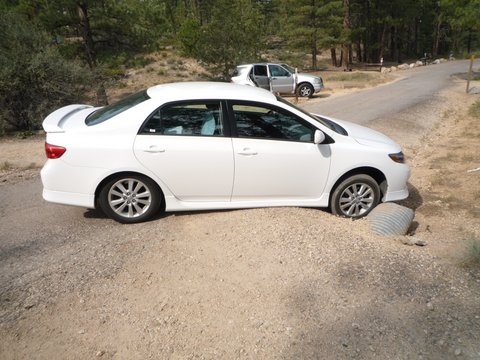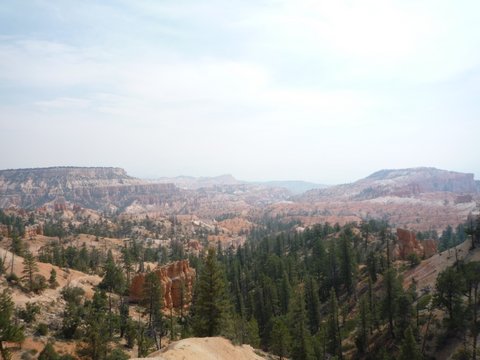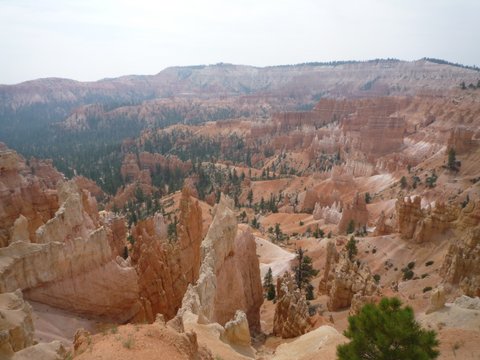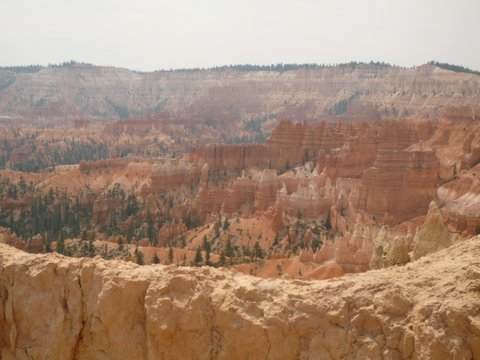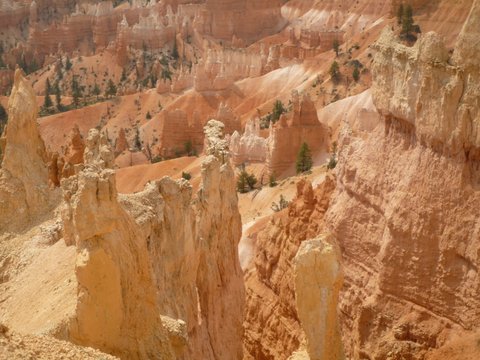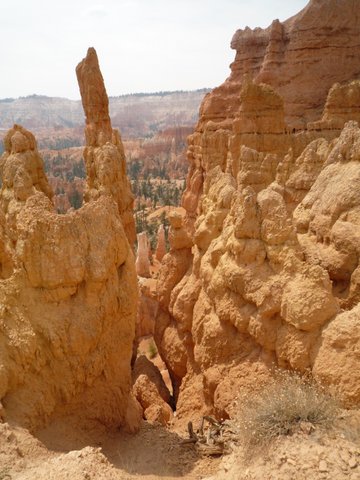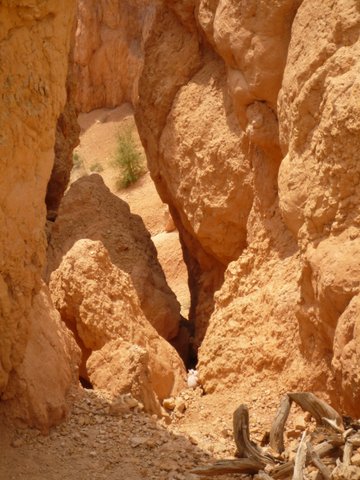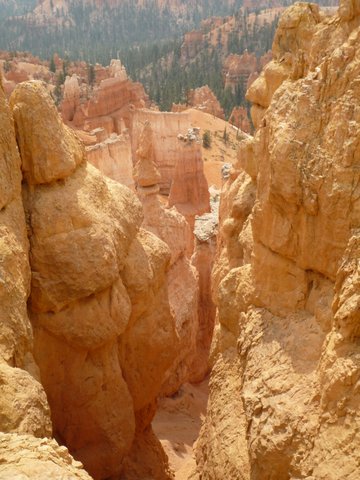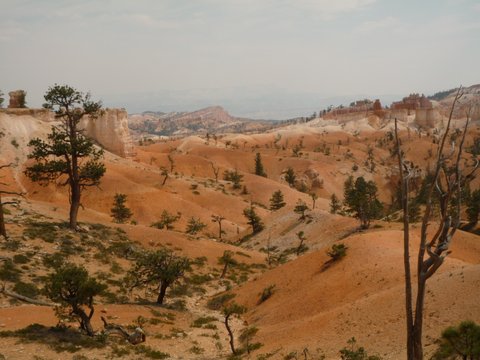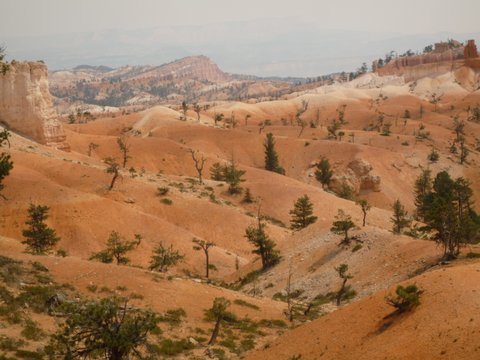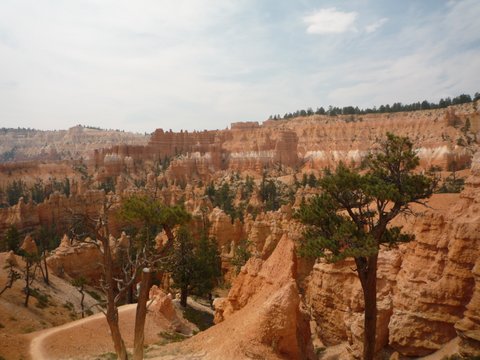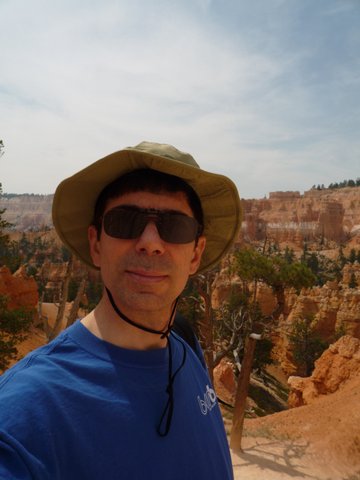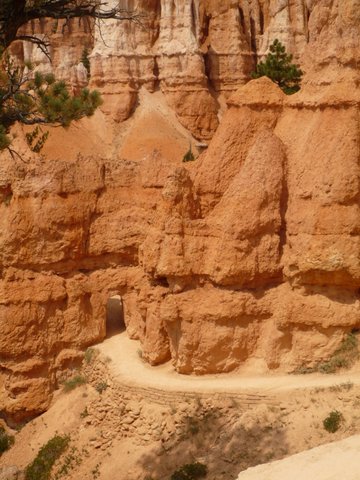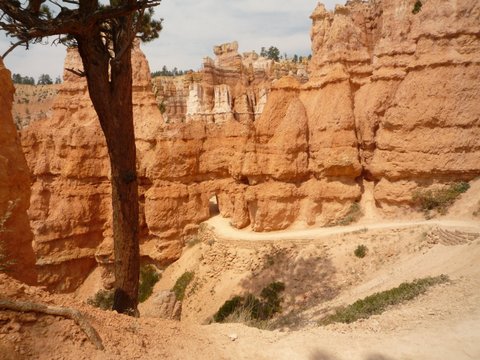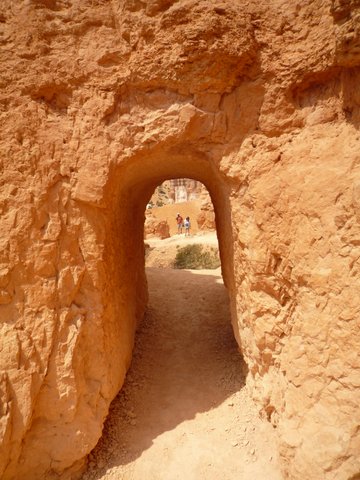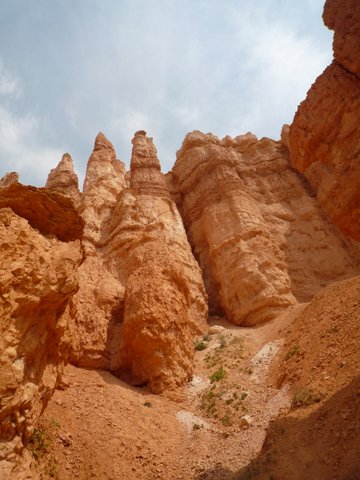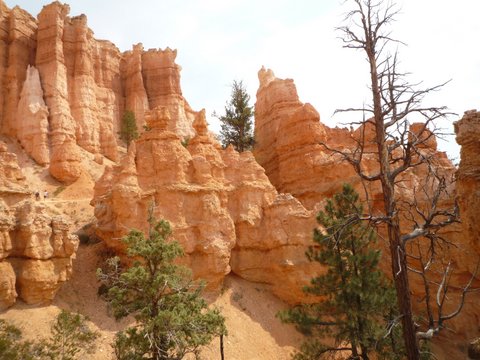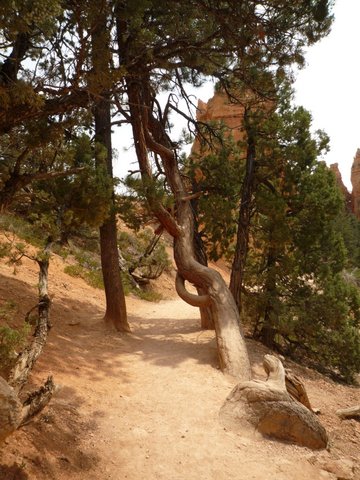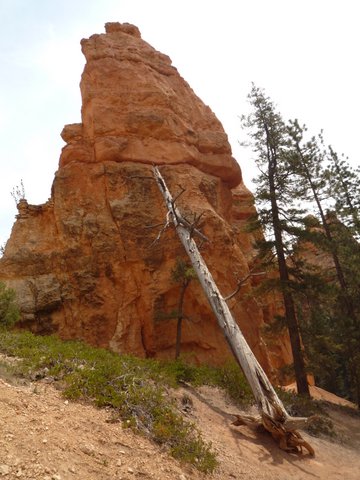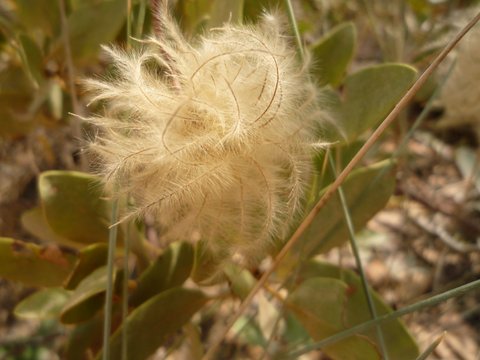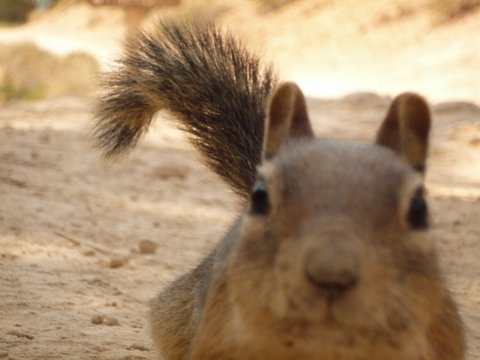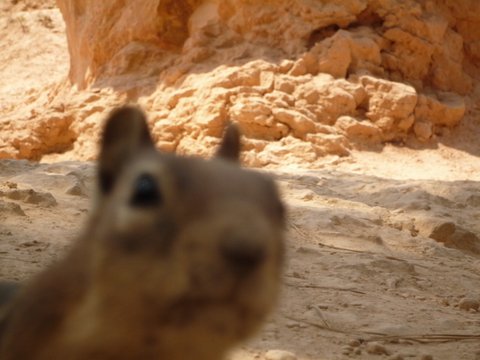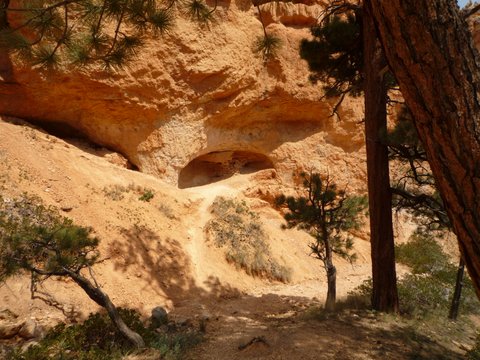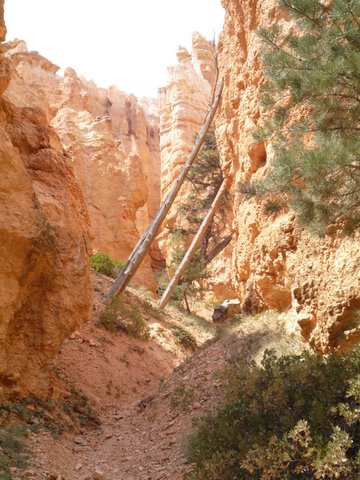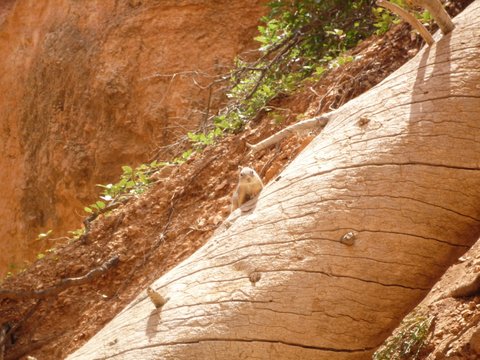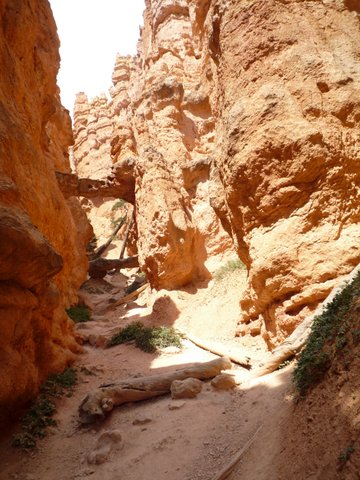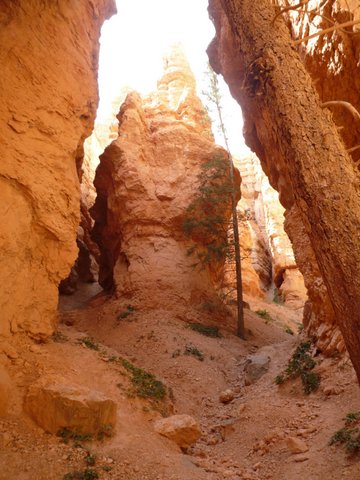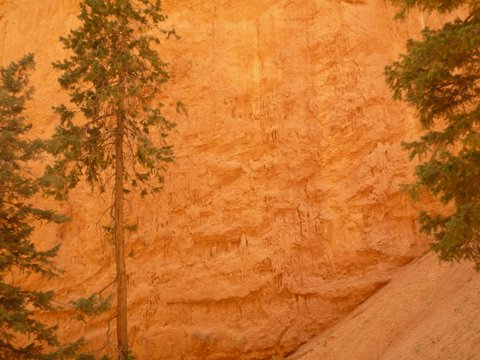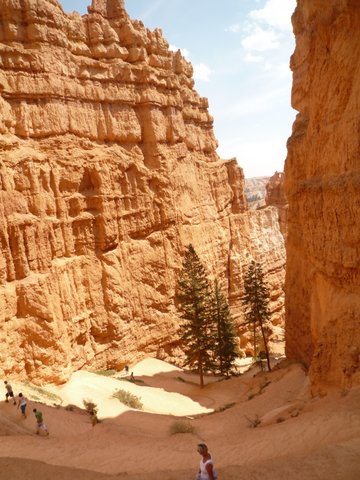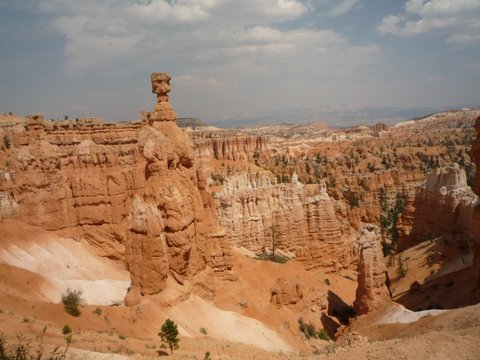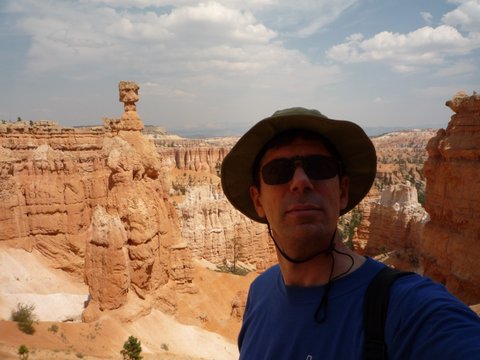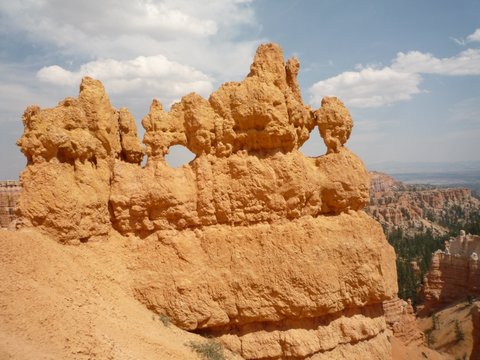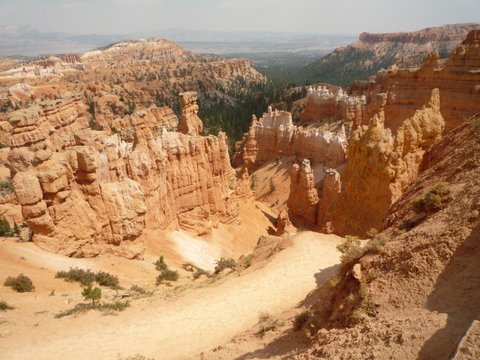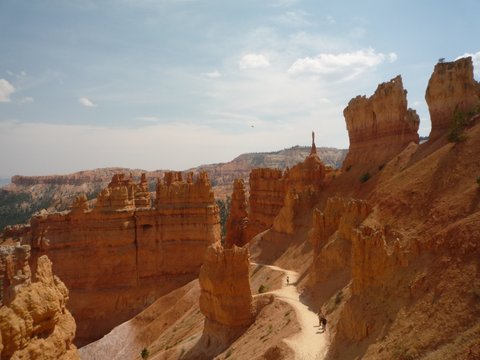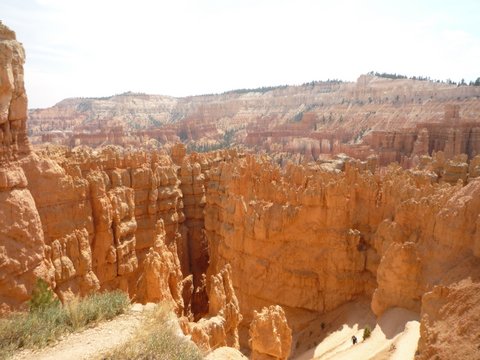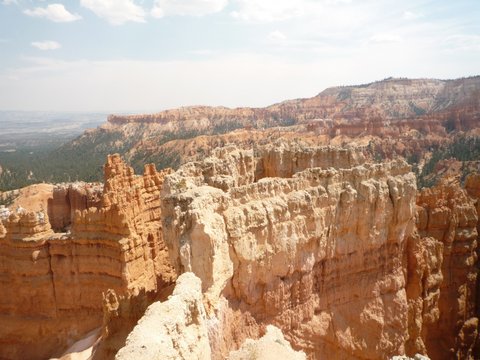Monday morning: By the way, what are Bryce Canyon and Zion National Parks? There’s a geological region called the Colorado Plateau, which takes up a big chunk of the “Four Corners” states: Colorado, New Mexico, Utah and Arizona. This plateau has the greatest concentration of national parks in the United States. Scientists say that the region was once flat land, was then pushed up by tectonic activity, then slowly eroded over millions of years.
Bryce Canyon wasn’t eroded that much, so it’s still near the top of where the plateau originally was. Zion has been eroded more, so it’s at a lower elevation and exposes lower geological formations than Bryce does. The Grand Canyon is the lowest level, exposing even lower geological formations. This reduction in geological layers across the three national parks is referred to as The Grand Staircase.
Bryce is known for red Navajo sandstone, striking in color. It’s also known for “hoodoos,” the name given to pillars of rock that are left standing. Native Americans believed that they were people who had been turned to rock.
I woke up and went for a shower. Typically, state parks have nice shower facilities (though that may vary by state), whereas national parks may be deficient in that regard. Bryce Canyon actually had a “Camp Store,” run by consignment, I imagine, which had showers. A shower was two dollars. The machines took dollar coins, which I obtained in the camp store. I didn’t know how long the shower would run, but it was more than enough time needed. There were five or six shower stalls, so there was no line.
I was at the park during a quiet week, as school had just started. Half of the tourists seemed to be foreigners, with half of those being German. I also heard French, Italian, and a few other languages. Of the Americans, many were retirees.
Also at the camp store, I bought a bottle of chocolate milk to supplement my breakfast bars. When I had first planned the trip, six weeks earlier, I had wanted to visit both Bryce Canyon and Zion National Parks. However, the campsites could be booked over the Internet, and the website showed that the Zion campsites were already full. I decided to book five nights at Bryce Canyon, thinking that perhaps I could drive over to Zion for a day trip. The website showed that Bryce Canyon’s campsite was also filling up, and I couldn’t find one site available for five nights. The best I could do was to get one site for one night, and then an adjacent site for four nights. Check-out was 11:30 and check-in was noon. The people at the adjacent campsite left early in the morning, and I was wondering if I could just carry my tent over there without disassembling it, but I didn’t know what to do about the fact that they were expecting no one to be at that campsite between 11:30 and noon. In the end, I decided that it would be simple enough to break down the tent, only taking a few minutes, and reassemble it. So I took it apart, put it in my car, and prepared to drive off, intending to return later in the day to the adjacent campsite.
I didn’t make it far. I backed the Corolla out of the driveway of my first campsite, and saw there was a pole behind me that I didn’t want to hit, so I didn’t back up too far. (Since it was a rental car, I wasn’t that comfortable with how close or how far I was from objects.) I then turned the wheel to the left and put the car into drive. I knew there was a drainage ditch in front of me, but I thought I cleared it. However, as I started to creep forward, I felt the car drive onto soft gravel and then quickly slide into the ditch. An Asian man camping nearby came over and with the help of another man tried pushing the car out of the ditch, but it was hopeless. At least the car wasn’t at all damaged, just stuck:
The Asian man’s wife used her cell phone to call the Park headquarters and reported that there was a car stuck in the mud. Her children tried correcting her that it was gravel, as this was a desert environment that had been pretty dry. [In fact, on the drive down to the Park, I had heard on the radio about forest fires that were threatening to destroy homes in New Harmony, and the radio said that residents should be prepared to abandon their homes at a moment’s notice!]
A friendly Park law enforcement ranger arrived, and asked how I was doing. “Embarrassed,” I answered. He laughed. He confirmed that I would need a tow truck to extricate the car, and said that at least it was right outside the park, so it wouldn’t take long to arrive or cost much. It took about a half hour for the driver to arrive. The tow truck driver said that the Park headquarters had told him that a car was stuck in the mud, and he thought it was a practical joke. He attached hooks to the frame of the car and quickly winched it back onto the road. This only cost me $65.
However, something good came of this incident. The ranger had said, “Oh, since you’re in this campsite, I guess you reserved online. We don’t like that program too much, because we have to give up a part of the camping fee to the company that has the website consignment, but the National Park Service makes us participate. However, we only list about a quarter of our campsites online.” I said, “you mean that you have other campsites that have vacancies?” “Oh, yes,” he answered, “there are only about four days a year that we totally fill up all our campsites.”
I guessed that the situation was the same at Zion, and that while I had thought that it was booked, there were probably many unlisted campsites there that were available. So I decided that I would spend two days at Bryce and then relocate to Zion! The campsites at Bryce were only $15/day, so the fact that I was abandoning the campsite after having paid for two days that I wouldn’t use only meant that I was throwing away $30.
My rental car free from the clutches of the gravel, I drove a short distance to Bryce’s Sunrise Point, put on my boots and enjoyed what some have called, “the best three-mile hike in the world,” hiking down into the canyon on the Queens Garden Trail and back up to the rim on part of the Navajo Loop Trail.
This is what I saw:
I recorded my presence in this beautiful place.
In addition to the grand rock formations, there were also pretty flowers there. Perhaps some botanist will be able to identify this one for me, and I’ll edit my report to include the name.
At the bottom of the Queens Garden Trail were a couple of benches, and while sitting there, a chipmunk came to visit. They were all over the park. The Parks ask people not to feed the animals, and make the pitch from several angles. One angle is that if you feed animals with human food, it will hurt their digestive system and they will die. Another angle is that if you feed animals, they will not learn how to forage for food on their own and will starve to death during the winter months when there are no tourists. Another pitch the Park makes is that the animals could be harmful to humans. At Zion, they had a photo of someone’s hand with a few scratches and a number of stitches between two knuckles and other stitches visible near the webbing of the hand, which they said was caused by a squirrel. But I hadn’t seen that photo yet, nor heard that rodents can carry a form of plague and Hantavirus, so I watched with amusement as this chipmunk jumped onto the bench next to me, put his paws on the leg of the German tourist sitting there, and then ran across the man’s arm.
I didn’t see anyone feed any animals, but I think that it must happen, considering how tame they are, and some other tourists at this site saw this chipmunk approaching so closely and said that he must have been fed quite a lot. He later came to visit me, climbing up my backpack (which was hanging from my knee as I was sitting on the bench) and sniffing my fingers. My only complaint was that the fellow wouldn’t stand still long enough for me to get a focused photograph.
Finally, I decided it was time to continue on, returning to the rim of the canyon by the Navajo trail. The great scenery continued:
A different chipmunk, saying ‘hello’:
Another self-portrait, with a hoodoo behind me, and a balancing rock in the background.
The Navajo Trail returns to the rim of the canyon at Sunset Point, where I shot a couple of photos, before walking along the Rim Trail the short distance back to Sunrise Point, where I had left the car.
At some point on the hike, I met a nice older couple from Arkansas. I also developed a bit of a sunburn. I rarely use sunscreen, but I decided to reconsider that.
Next: A trip to Mossy Cave.

